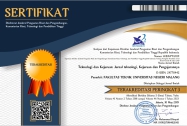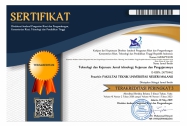Quality Improvement Needs for Vocational High School Teachers in Indonesia
Abstract
Vocational high school quality is determined by the workability of its graduates, the partnerships with business and industry, as well as the professionalism of its teachers. The purpose of this study is to identify the needs of quality improvement of vocational high school teachers in accordance with the Teachers’Disposition Index focusing on student-centered dimension, professionalism, and curriculum‐centered dimension. The study employed a questionnaire survey as the methodology, and the sample of the population was randomly selected 300 teachers in Indonesia. The findings showed that teachers need to improve their quality in the aspect of student-centered dimensions, including effective instructional strategies, responsibility, learning environment, and collaboration with others. While, professionalism and curriculum-centered dimension, including teacher’s knowledge and positive attitude, facilitation of learning, communication skill, and implementation of the curriculum and learning programs. Based on the results, our expectation is that vocational high school teachers should improve teaching quality by developing student-centered learning environment and teachers’ professionalism to make students learn more optimally.
Keywords
Full Text:
PDFReferences
Agezo, C.K., & Christian, G. (2000). The impact of economic environment on primary school attendance: a case study of elmina in the central region of Ghana. Journal of Educational Management, 4, 137-143. AITSL. (2011). National professional standarts for teachers. Australia: Australian Education Ministers. Akareem, H. S., & Hossain, S. S. (2016). Determinants of education quality: what makes students’ perception different?. Open Review of Educational Research, 3(1), 52-67. Al-Dajeh, H. (2012). Jordanian vocational, secondary education teachers and acquisition of the national professional standards. Education, 133(1), 221-232. BPSPDM & PMP. (2011). Quality assurance of education through programs. Jakarta, Ministry of Education and Culture. Çubukçu, Z. (2012). Teachers' evaluation of student-centered learning environments. Education, 133(1), 49-66. European Centre for the Development of Vocational Training (Cedefop). (2011). Assuring quality in vocational education and training the role of accrediting VET providers. Luxembourg: Publications Office of the European Union. Evans, L. (2011). The ‘Shape’ of teacher professionalism in England: professional standards, performance management, professional development and the changes proposed in the 2010 white paper. British Educational Research Journal, 37(5), 851-87. Faulkner, J., & Latham, G. (2016). Adventurous lives: Teacher qualities for 21st century learning. Australian Journal of Teacher Education, 41(4), 9. Furlong, J. (2001). Reforming teacher education, re-forming teachers: accountability, professionalism and competence. In, R. Philip & J. Furlong (Eds.), Education reform and the state: Twenty-five years of politics, policy and practice (pp. 118-135). London: Routledge/Falmer. Gibbs, G. (1992). Improving the quality of student learning. Plymouth UK: Technical and Educational Services Ltd. Indonesia Government. (2003). Act of the national education system No. 20 of 2003. Jakarta: Indonesia Government. Janor, H., Rahim, R. A., Rahman, A. A., Auzairy, N. A., Hashim, N. A., & Yusof, M. Z. (2013). Integrating student-centered learning in finance courses: The case of a Malaysian research university. International Education Studies, 6(6), 108-123. Kang, H. S., Cha, J., & Ha, B. (2013). What should we consider in teachers' professional development impact studies? Based on the conceptual framework of desimone. Creative Education, 4(4), 11- 18. Kember, D. & Gow, L. (1994). Orientations to teaching and their effect on the quality of student learning. Journal of Higher Education, 65, 58–73.
Didik Nurhadi, Quality Improvement Needs for Vocational High School Teachers in Indonesia Lea, S. J., D. Stephenson, and J. Troy. (2003). Higher education students’ attitudes to student centred learning: beyond ‘educational bulimia’. Studies in Higher Education, 28(3), 321–334. Lupascu, A. R., Pânisoară, G., & Pânisoară, I. O. (2014). Characteristics of effective teacher. Procedia-Social and Behavioral Sciences, 127, 534-538. Malik, R. S. (2018). Educational challenges in 21st century and sustainable development. Journal of Sustainable Development Education and Research, 2(1), 9-20. Minister of Education. (2010). Standard instrument of teachers and educators: supervision, monitoring, and evaluation. Jakarta: Directorate of Management General of Primary and Secondary Education in Indonesian. Ministry of Education and Culture. (2005). Law of teachers and lecturers. Jakarta: Ministry of Education and Culture. Ministry of Education and Culture. (2010). Strategic plan for the ministry of education and culture 2010-2014. Jakarta: Ministry of Education and Culture. O’Neill, G., & McMahon, M. (2005). Student-centred learning: What does it mean for students and lecturers emerging issues in the practice of university learning and teaching, AISHE, Dublin, from http://www.aishe.org/readings Obidike, N. (2016). Factors affecting teacher quality practices in primary schools in Awka educational zone, Anambra State. African Journal of Teacher Education, 5(1), 1-8. Rose, J. W. (2008). Professional learning communities, teacher collaboration and the impact on teaching and learning. (Order No. 3311359, Lewis and Clark College). ProQuest Dissertations and Theses, 224-n/a. Rustiadi, S. (2015). Creating better education system, building stronger human capital: A creative industries perspective. Procedia-Social and Behavioral Sciences, 169, 378-386. Schulte, L., Edick, N., Edwards, S., & Mackiel, D. (2006). The development and validation of the teacher dispositions index. Retrieved on December 13, 2006, from www.usca.edu/essays/vol122004/schulte.pdf Serdyukov, P. (2017). Innovation in education: what works, what doesn’t, and what to do about it?. Journal of Research in Innovative Teaching & Learning, 10(1), 4-33. Slamet, P. H. (2013). Developing vocational school model for the future. Journal of Cakrawala Education, 17(1), 14-26. Sujianto, Mukhadis, A., & Isnandar. (2012). Professionalism sustainable development of certified teacher educators in SMK of technology race. Journal of Vocational Technology, 35 (1), 1-12. Taylor, S. C. (2017). Contested Knowledge: A Critical Review of the Concept of Differentiation in Teaching and Learning. Warwick Journal of Education-Transforming Teaching, 1, 55-68. Thornburg, D. (1995). Student-centered learning. Electronic Learning, 14(7), 18-19. Young, S. (2004). Professionalism is illustrated through your actions. The Canadian Appraiser, 48(1), 22-23. Zuber, J., & Altrichter, H. (2018). The role of teacher characteristics in an educational standards reform. Educational Assessment, Evaluation and Accountability, 30(2), 183-205.
DOI: http://dx.doi.org/10.17977/um031v43i12020p35-40
Refbacks
- There are currently no refbacks.
Copyright (c) 2020 Teknologi dan Kejuruan: Jurnal Teknologi, Kejuruan, dan Pengajarannya
Teknologi dan Kejuruan: Jurnal Teknologi, Kejuruan, dan Pengajarannya
E-ISSN 2477-0442 (online)
Contact
Faculty of Engineering, Universitas Negeri Malang (UM)
Jl. Semarang No 5 Malang 65145, Building H5, 1st Floor.
Homepage: http://journal2.um.ac.id/index.php/teknologi-kejuruan
Email: teknologikejuruan.ft@um.ac.id

This work is licensed under a Creative Commons Attribution 4.0 International License.



2.png)
1.png)
1.png)
1.png)
4.png)
1.png)
.png)

3.png)
1.png)
1.png)


